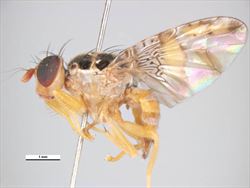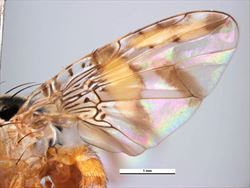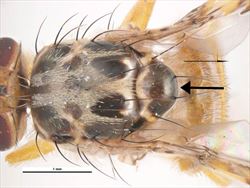AUTHORS Graham Walker & Grahame Jackson
Information from Waterhouse DF, Sands DPA (2001) Classical biological control of arthropods in Australia. ACIAR Monograph No. 77, 560 pp.; and CABI (2020) Ceratitis capitata (Mediterranean fruit fly) (https://www.cabi.org/cpc/datasheet/12367); Broughton S (Undated) Fruit fly monitoring in commercial orchards. Agriculture and Food Division, Department of Primary Industries and Regional Development. Government of Western Australia. (https://www.agric.wa.gov.au/medfly/fruit-fly-monitoring-commercial-orchards). and Broughton S (Undated) Controlling Mediterranean fruit fly in orchards: mass trapping and attract-and-kill devices. Agriculture and Food Division, Department of Primary Industries and Regional Development. Government of Western Australia. (https://www.agric.wa.gov.au/medfly/controlling-mediterranean-fruit-fly-orchards-mass-trapping-and-attract-and-kill-devices); and Broughton S, McCarthy A (Undated) Mediterranean fruit fly life cycle & biology. Agriculture and Food Division, Department of Primary Industries and Regional Development. Government of Western Australia. (https://www.agric.wa.gov.au/medfly/mediterranean-fruit-fly-life-cycle-biology); and The Australian Handbook for the Identification of Fruit Flies (2018) Plant Health Australia. Canberra, ACT. (Version. 3.1). (https://www.planthealthaustralia.com.au/wp-content/uploads/2018/10/The-Australian-Handbook-for-the-Identification-of-Fruit-Flies-v3.1.pdf); and from Yates. Fruit fly control in your garden (https://www.yates.com.au/plants/problem-solver/pests/fruit-fly/). Photos 1-5 Walker K (2006) Mediterranean fruit fly (Ceratitis capitata). Museum of Victoria: PaDIL - http://www.padil.gov.au. Diagram McDougall S, et al. (2013). Tomato, capsicum, chilli and eggplant: A field guide for the identification of insect pests, beneficials, diseases and disorders in Australia and Cambodia. Australian Centre for International Agricultural Research (ACIAR). (http://aciar.gov.au/files/mn-157/index.html).
Produced with support from the Australian Centre for International Agricultural Research under project HORT/2016/185: Responding to emerging pest and disease threats to horticulture in the Pacific islands, implemented by the University of Queensland and the Secretariat of the Pacific Community.









